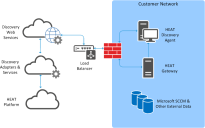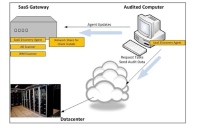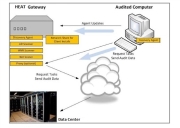Service Manager powered by HEAT
How HEAT Discovery and Inventory Auditing Work
The following diagram illustrates how the different components involved in inventory management communicate with each other:
Inventory Management Components
ISM Discovery and the creation of configuration item records is accomplished by:
•Performing an Active Directory scan from a Ivanti Service Manager gateway.
•Doing a ping discovery on the IP address ranges using a module called Netscan, (included in the data center gateway installation). Netscan IP ranges are set on the gateway.
•Running a client agent process called Netscan, that listens for network traffic and then queries devices on the network using SNMP. SNMP queries are set on the gateway.
•Gathering data via SCCM and other external sources that communicate directly with the asset processor and other adapters.
•Importing data from ISM Discovery Release 9.3.x or later, using the utility.
•Importing from an external file using the business object uploader.
•Manually entering the data.
The following table displays various discovery methods available with ISM Discovery methods included with ISM Discovery:
|
Method |
Deployed From |
Discovers |
OS Support |
CI Types Discovered |
|---|---|---|---|---|
| Client Agent |
Audits the machine on which it is installed. Set polling interval from inventory settings. See also Service Manager powered by HEAT. |
device name MAC/IP address operating system software hardware |
Windows Mac UNIX: HP UX, AIX, Solaris Linux: Ubuntu, Red Hat, SUSE |
Servers Workstation VirtualServer VirtualWorkstation |
|
Agentless Audit or Remote Scan |
From a gateway, audits other machines on the network. This only works for the Windows operating system using a WMI query. See also Service Manager powered by HEAT. |
device name MAC/IP address operating system software hardware |
Windows OS only |
Servers Workstation VirtualServer VirtualWorkstation |
|
LanProbe |
Client agent installed on machines. Collects information to update CI records. LanProbe settings (including polling frequency) are configured from the Details tab. See Using the Inventory Settings Workspace and Working with LanProbe for more information. |
device name MAC/IP address |
Scans for any device within a client's subnet or configured subnets that have SNMP-enabled devices. It also discovers the MAC address and host name from DNS and ARP |
Collects deltas and updates previously created CI records. Computers Servers Workstations (physical and virtual) Routers Switches VOIP Printers Scanner Access Point UPS Firewall SAN Hub |
|
Netscan |
Scans for Window-based or SNMP-enabled devices connected to the network. Is scheduled and runs only from a Gateway Data Center Edition workspace. Set ranges from the Netscan IP-Ranges tab in the Gateway Data Center Edition workspace. For more information see Using Netscan |
device name MAC/IP address operating system |
Only used for Windows or SNMP enabled devices |
Computers Servers Workstations (physical and virtual) Routers Switches VOIP Printers Scanner Access Point UPS Firewall SAN Hub |
|
Active Directory Scan |
Gateway and Gateway Data Center Edition works only with Windows Server or workstations on Active Directory |
device name MAC/IP address operating system |
Windows machines listed on Active Directory Servers Workstations VirtualServer VirtualWorkstation |
After initial discovery, the system audits assets to collect additional data. Auditing of the discovered assets is accomplished by:
•Installing the ISM Discovery client agent on the computer to be audited.
•Remotely auditing via a WMI scanner that runs on the Ivanti Service Manager gateway.
•Performing an SCCM import.
•Performing an import from ISM Discovery Release 9.3.x or later.
•Uploading a file.
The following table compares information gathered by audits using the installed ISM Discovery client agent versus remote scan:
|
Method |
Operating System Support |
Hardware |
Software |
Software Usage |
File Info |
Deltas |
|
ISM Discovery Client Agent |
Windows Mac UNIX: HP, AIX, Solaris Linux: Ubuntu, Red Hat, SUSE |
Yes |
Yes (both Add/Remove programs entries and software files) Greynet software is identified by comparing the discovered software to a pre-defined table. |
Yes |
Yes |
Yes |
|
Remote Scan (WMI) |
Available only for Windows |
Yes |
Yes (only Add/Remove programs entries) |
No |
No |
No |
Active discovery involves installing the Ivanti Service Manager gateway on a computer or doing a ping sweep to establish a range of IP addresses that map to live hosts, and then doing an Active Directory scan.
Passive discovery uses LanProbe (an installed client agent) to listen to your network activity and identify new devices when they are added or connected to the network.
For clients and gateways, the Ivanti Service Manager gateway communicates via HTTPS to the client data web service. The data is in turn processed by ISM Discovery processors, that populate the configuration management database with inventory information. Inventory data is also gathered by SCCM and other external sources, which communicate directly with the ISM Discovery processors and other adapters. In case of a gateway proxy, the client sends messages to the proxy which in turn forwards the messages to the server. Gateway proxy is usually used in environments where there is limited network access.
The Ivanti Service Manager gateway must be installed on one or more computers (or servers) or on a proxy server in your network in order to use discovery methods (such as ADScan, Deploy Agent, NetScan etc.). To install a gateway, see Service Manager powered by HEAT. SeeManaging Gateway Workspace Settings to learn more about your gateway settings.
If you are using the Ivanti Service Manager gateway to deploy agents to other client machines, you must have full administrator rights and privileges on those client machines.
•To manage the computers that are currently not audited: You need to deploy a client agent to the computers as described in Deploying Agents to Other Computers. This agent allows the subsequent Inventory process to discover all network computers. You can also install agents on remote computers, as described in About Installing Agents on Remote Computers.
•When the gateway has been installed: It can deploy client agents to other computers. When a client agent has been installed on a computer, it automatically performs an initial full audit (see Running an Active Directory Scan). You can also use the gateway computer to do a remote audit on the client computers without the need to install client agents (see About Agentless Audits).
•In cases where it is not feasible to install a client agent on a networked computer: You can remotely audit the machine by using Microsoft WMI infrastructure (Windows Management Instrumentation), which allows the gateway to audit computers remotely. Agentless auditing is done by a gateway machine running WMI queries against the target computers. See About Running Agentless Audits.
•When data is gathered for inventory either by the agent audit or by remote auditing from the agent or the gateway: The audit data is sent to the Ivanti Service Manager data center web service via a secure HTTPS protocol. The received data is processed in two steps: the raw ISM Discovery agent data and is processed into a generic format (for example, the names of publishers and hardware are normalized); then the normalized data is populated into the configuration management database.
The Ivanti Service Manager agent and the Ivanti Service Manager gateway also communicate with the message processor to determine if there are tasks to process. The message processor is a component on the Ivanti Service Manager server, which provides tasks for the gateways and for the clients through a web service. A task for a gateway can be, for example, "install Ivanti Service Manager client on machine X" or "update configuration." A task for a client can be, for example, "update configuration" or "audit computer now."
The following diagrams show how data flows from the audited computer to the data center without a proxy and then with a proxy:
Data Flow Without a Proxy
Data Flow With a Proxy
Was this article useful?
The topic was:
Inaccurate
Incomplete
Not what I expected
Other
Copyright © 2017, Ivanti. All rights reserved.


